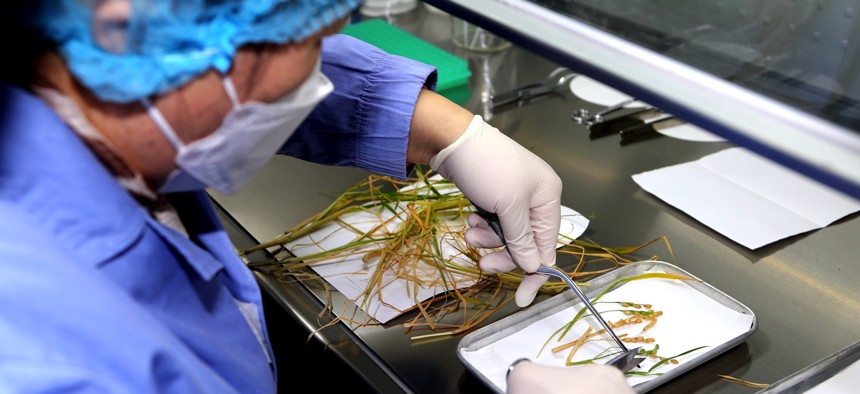
A researcher processes rice samples from China's Tiangong space station at the Chinese Academy of Sciences' Center for Excellence in Molecular Plant Sciences in Beijing, China, on Dec. 5, 2022. Xinhua via Getty Images
China ‘Colonizes’ Space with Its First Rice Harvest
The cultivation of food in orbit is part of a larger push by the Chinese space program toward a lunar base.
“Once you grow crops somewhere, you have officially ‘colonized’ it.” This line from the character Mark Watney captures one of the most important moments in the story The Martian, when the stranded astronaut finally learns how to sustain himself over the long term—and legally stake his claim to the planet.
In the real world, China recently reached a similar milestone in the human habitation of space, with the announcement by the Chinese Academy of Sciences that rice seeds had been harvested on the Chinese Tiangong space station. This achievement represents an especially large step forward for China’s greater plans towards permanent human settlement on the Moon and beyond.
The future crops were brought to space as seeds, and spent 120 days germinating and growing on the space station. Eventually, the crops produced their own seeds, and the samples were returned to the Space Application Engineering and Technology Center in Beijing, as part of the end phase of the Shenzhou-14 mission to the Tiangong space station. The crops and new seeds are being analyzed to determine their viability and what effects developed from a full life cycle in space.
The cultivation of food in space is part of a larger push by the Chinese space program toward a lunar base. Although China entered the space race in 1970 by launching the Dong Fang Hong 1 satellite, it wasn’t until 2003 that China launched its first crewed space flight. Not long after, China set its sights on the Moon, achieving a year-and-a-half-long orbit from November 2007 to April 2009. In 2011, China launched the first phase of its space station program, the Tiangong-1. The station achieved its goal of continuous orbital habitation just a few months ago with its completion in November. Eventually, the information gathered from a permanently manned space station, along with the crops grown on it, will contribute to the next step in the burgeoning new space race between the United States and China: human settlement of the Moon.
Currently, the China National Space Administration is aiming to start construction on a lunar settlement by 2028. The plan calls for the robotic Chang’e-7 rover to land on the Moon’s south pole in 2026 and hunt for water and other resources. Originally, the follow-up Chang’e-8 robot was to continue the Chang’e-7’s exploration and find the best location for the International Lunar Research Station at the lunar south pole in 2028. However, it appears that the timeline was sped up last year, and the Chang’e-8 is now to begin initial construction of the facility and demonstrate its feasibility.
China’s compressed timeline appears to be a response to NASA’s own plans to return to the Moon. The Artemis III landing, including the first-ever woman and astronaut of color to land on the Moon, is scheduled for the end of 2025. After this, NASA and international partners aim to establish a Lunar Gateway space station in lunar orbit. This space station would be used as a staging point to ferry personnel to NASA’s own Moon base, the Artemis Base Camp.
Both the Chinese and U.S. lunar bases are planned to be placed on the Moon’s south pole, thought to contain frozen water ice, a critical resource for permanent habitation. With close to 200 days facing the sun, the lunar south pole also experiences much more stable temperatures than other parts of the Moon. This sunshine would also allow for consistent solar power generation. All of this makes it a prized strategic location for a future base, and a potential area of new competition.
Building a permanent settlement on the Moon is desirable for multiple reasons. Foremost, the Moon contains large amounts of helium-3, an element which is both difficult to obtain on Earth and thought to be extremely useful in future nuclear fusion reactors. A Moon base is also desirable as a proving ground for technology that would eventually be used for the settlement of Mars. Traveling to the Moon takes about three days, compared with the seven months required for Mars. If a problem arises or a piece of technology is not working as intended, it is much easier to mount a successful rescue operation to the Moon. Third, a Moon base is also desirable as a staging ground for asteroid mining of rare earth minerals.
The final reason is, of course, the new space race. China’s space budget was an estimated $10.8 billion in PPP for the year 2013, placing it the second-highest in the world. Its space program is a source of great national pride and receives a high amount of attention and political will from its senior leaders. This is particularly true since 2011, when the U.S. Congress forbade NASA to work with Chinese space agencies after a series of espionage revelations. Since then, China has worked overtime to find international partners, sign cooperation agreements, and build out its program.
Although China has been racking up experience in space, the accelerated timeline puts greater pressure on the China National Space Administration and could even force it to make moves before programs are fully ready. China’s Mars exploration is already experiencing some problems, with its Zhurong rover stalled on Mars and possibly facing shutdown. Regardless, with its latest achievement, China has made one small step for farming, one giant leap for its long-term space aspirations.
Thomas Corbett is a research analyst with BluePath Labs. His areas of focus include Chinese foreign relations, emerging technology, and Indo-Pacific security studies.